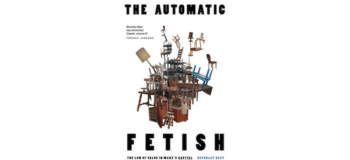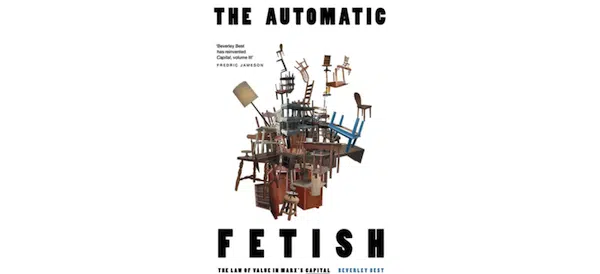
Beverley Best
The Automatic Fetish: The Law of Value in Marx’s Capital
Verso, New York, 2024. 358 pp., $29.95 pb
ISBN 9781804294802
Capitalist crises cannot only be measured by its catastrophic effects on society, but also by the reception of their most staunchest critique: Karl Marx’s Capital. Many have pointed out that the rising interest in Marx’s magnum opus seemingly coincides with capitalism’s deepest moments of crisis, as if it suggests discontent with the present system. With much attention given to volume one or the many drafts to which it culminated, until recently there has remained little attention to the subsequent volumes of Capital. Beverly Best’s new book, The Automatic Fetish: The Law of Value in Marx’s Capital, contributes to this growing resurgence and gap by taking Marx’s value theory and using it to read volume three. This work is nothing short of a masterful reading of Marx’s form-analysis and defends the continued relevance of Marx’s work in the twenty-first century.
In a critical and methodological reading, Best uproots ‘capital’s hidden, inner movement and the identification of its historical conditions of emergence’ to study what she calls ‘capital’s perceptual physics’(9). Her work responds immediately to critics of value-form theory who conceive of it as a narrowed reading of the first few chapters of Capital, demonstrating how Marx’s initial investigation of value and its forms undergird the whole of Capital. Her argument hinges on the centrality of volume three for the critique of political economy, which she argues is ‘a theory of a particular movement that generates new percepts – a movement arising from collective uncoordinated activity that, over a couple of centuries of objectification through repetition, produces a particular appearance of things that launches a specific world history’ (326). In short, she takes the concept of fetish and asks what economic forms it distorts once capital is moving through its M-C-M’ circuit.
As Best shows, it is one thing to analyze the fetish-character of capital in the ideal-average scenario that Marx constructs at the beginning of volume one, but quite another to analyze fetishism in volume three where there ‘is both a broadening and a focusing of the concept’ (48). In building this analysis, Best gives one of the most detailed accounts of the consequences of capital’s fetishized forms inherent in its movement for the study of political economy. By placing value-theory at the center of volume three, Best is able to draw radical conclusions for the study and critique of economics and how the law of value maintains the coherent core of Marx’s project.
The book is organized as a companion to volume three and is made up of two sections which trace out the internal dynamics of capital’s ‘perpetual physics.’ The first section deals with the rate of profit, the fetish of the rate of surplus-value, to showcase how production, competition and finally crisis distort and contort the misery of the production process into a blind pursuit of M-M’. Best begins with the category of cost price to show how it ‘is the initial category from which all others will derive’ (23). Cost price, ‘a disciplining objective appearance’, is essentially the cost incurred by the capitalist to produce a commodity (18-19). It becomes the basis for competition since as long as a commodity is sold above the cost price, it can be sold below its value allowing for competitors to undersell and take a bigger share of the market. From this initial obfuscation, Best demonstrates how capital’s movement obscures the source of surplus-value, the subsumption of labor-power to ever increasing productivity, which as a result makes capitalist’s pursuit of profit a rational outcome in a commodity producing society. As she says, ‘[f]rom the standpoint of the capitalist, the only calculation of concern is rate of profit – the immediate form of appearance that today dictates global production and commerce across the world market’ (36). In short, Best demonstrates how the creation of surplus-value is obscured by the machinations of the economy as capitalists pursue profit as if money can magically double itself.
The second section deals with the metamorphosis of profit, following ‘Marx’s exposition of the decomposition of profit into the surface forms of industrial profit, commercial profit, interest, and ground rent’ (137). It is ultimately an examination of the forms of profit that obscure the ‘hidden abode of production’ across the M-C-M’ circuit, concealing the costs incurred on the lives and bodies of workers. Best unravels the deep irrationality that drives the capitalist pursuit of profit across industries, from agriculture and industrial production, finance and commerce in this theoretically dense yet prescient analysis. Part of the charm of the book is following Best’s excavation of these fetish forms and how they distort perceptions to pursue appearances, while the essence of the matter is driven by the subjugation of the working class to the few. The consequences of the movement of capital are vast, and to preserve people’s own experience, following Best’s exposition, I will highlight two key parts of the book: Marx’s theory of crisis and the analysis of ground-rent.
The chapter on crisis foregrounds capitalism’s dialectical identity as creative destruction. In recent years, this idea of crisis as an internal mechanism to ensure its reproduction has gained a lot of traction. What Best offers, in reading volume three, is an interpretation of crisis as an internal dynamic of capitalism itself, instead of an aberration of equilibrium. In Best’s own words, crisis is ‘the means by which capital displaces the obstacles it erects between itself and its singular objective’ (123). Yet it is not simply a negation of an obstacle that characterizes capitalist crisis; it is a negation of a contradiction by way of a contradiction: the universality of separation. This contradiction, expressed through crisis, is one of capitalism’s oldest conditions, and Best highlights how separation undergirds capitalism’s crisis tendency to render certain sectors superfluous in order to grow other sectors of the economy, to increase its flexibility to build regimes of accumulation. In this light, crisis at once tears down its own boundaries to erect new ones that it will eventually be forced to confront down the road of history. What lies behind this creative destruction, as Best describes, ‘entails precarity, unemployment, poverty, illness, gendered and racialized violence, and social exclusion’ of proletarians the world over (130). The movement of capital invokes a complicated question about the crisis tendency of capitalism into a simple one: why must capitalists instrumentalize humanity as a means to an end, that is, money that begets more money?
Ground-rent, the fetish form of landed property, occupies a significant chapter in the book and for good reason. The Financial Times recently published an article noting the significant increase in market value of arable land in the United States, causing private-equity to lead the charge in adding this asset to their portfolios. This phenomenon stands in stark contradiction to the many experiences of family-run or small farmers and ranchers in the US who, in many cases, are facing the heightened competitive pressures of an increasingly industrialized agricultural production, thus going out of business, paying more taxes and rent, as well as producing commodities for the market rather than for need. Marx, according to Best, provides the key to understanding this situation with the idea that ground-rent obscures the productivity of living labor as the source of surplus-value (250-251). The consequence is that ground-rent can increase even as the productivity of labor decreases, the prices of agricultural commodities goes up and the rate of profit demonstrably declines for agricultural production on a global scale. These tendencies arise from the movement of capital and, as Best says, ‘the virtually infinite ways in which human beings can be in metabolism with land are subordinated to the exigencies of the capital-labour relation – that is, to the law of value’ (243). Ground-rent shows itself as a form of social domination that subordinates land to the control of landowners for the sole purpose of making money from money. It renders land into a means for a ridiculous end, when agricultural products like food are produced not to satisfy hunger but again, to generate profit for landowners.
It is hard to disagree with Best’s work given its thorough reading, careful argument and clarity in demonstrating Marx’s internal coherence. Yet we might doubt Best’s assertion that Capital is, among many other things, ‘not a study of capitalist society, it is a book about how to think the material conditions of what might come after’ (341). While the task of critique is to comprehend the present in order to build a meaningful alternative to human society, uncertainty as a necessary mediation for its construction could be defended. While it is appealing to posit a latent kernel to be excavated for a future society, particularly after forty years of capitalist counterrevolution, we might nevertheless wonder what possibilities would be closed off if this were the case. Certainly, we need to understand and critique capitalist society in order to draw a path forward from its retched depths, and in so doing theorize alternatives. But we should also recognize the limits of our own imagination as it is determined by this base.
Despite this very minor point, The Automatic Fetish makes a strong case for why people should grapple with Marx’s work in its entirety and as an incomplete work that requires its application to the current political conjuncture. Best illuminates how the movement of capital produces dizzying heights and hidden surfaces that make capital’s reproduction possible. While the book gives focus to volume three, it draws much needed attention to all three volumes, which needs to be done if we are to adequately understand the value of Marx’s work. Best’s work recovers Marx’s essential critique of political economy, which revolves around its subordination of humanity to mere means for the ultimate end of making more money. Readers ought to sit with the book and work through it alongside Marx’s Capital. Its difficulty will reward the careful reader who applies its findings in the analysis of our present conjuncture, bringing economic science down to earth to show why another world is and must be possible.

